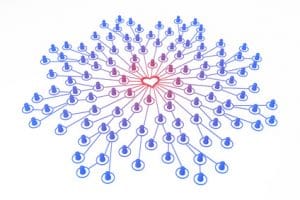How we can influence other people… mislead them (unconsciously) or – heal them!

Dr David Sobel from Kaiser Hospital in California told the story* of a doctor who treated an asthma patient. The patient was experiencing severe attacks, so he went to the doctor for pills. The doctor ordered a sample of the latest asthma medicine from a pharmaceutical company and gave it to the patient. He told him that it was a new, very powerful medicine that should take effect immediately.
Within minutes of taking it, the patient felt great relief – the medicine was really good and had an immediate effect! The doctor became curious about the effect on the patient of simply believing that he had taken the medicine, when in fact he had not. He decided to offer the patient a placebo. (A placebo is usually used to describe a substance that does not contain any substances that are effective in the treatment. For example, a sugar pill or distilled water “packaged” in the form of a medicine.) On his next visit, he gave the patient a pill that looked like the real thing, but did not contain any healing chemical substances; he just did not tell the patient this.
The latter complained that this time there was something wrong with the medicine, as it did not completely eliminate his problems.
This reaction convinced the doctor that the first drug was really good and had an excellent effect on asthma attacks, while the second – a placebo – also performed as expected, or as generally believed: it helps – because of the psychological effects – but somewhat less, as it does not contain any healing substance. Some time later, he received a notice or apology from the pharmaceutical company. There was a mistake – the first medicine was a placebo. The story tells us about two important factors in the process of information transfer:
- the strength of the patient’s beliefs and their relationship to authority (the doctor),
- the extraordinary effect of the doctor’s beliefs, which were transmitted to the patient with practically the same intensity as the doctor’s experience.
Let’s look at each of these two points separately.
1) The power of faith or how the mind dominates matter

Personal belief or faith has enormous power. Often, just an unwavering faith or trust in suggestion can achieve what no medicine can. In his book “The Power of the Unconscious”, author Joseph Murphy gives example after example of how people have succumbed to the power of faith or suggestion, with negative or positive effects:
- A relative of Murphy’s was cured of severe tuberculosis overnight when his son brought him a ring that was said to contain wood from the cross on which Jesus was crucified. Fact: The son had picked up the wood shavings in a carpenter’s shop, but told his father that he had paid very dearly for them because they came from the cross of Jesus.
- A passenger on a ship gets seasick when the captain tells him he looks unwell and something is bothering him.
- Murphy cured his skin cancer with the help of suggestion and trust in a cure.
- Under hypnosis, the man smelled what he was told was pepper water and started sneezing.
- The girl had arthritis and a mild but incurable skin condition. For years, her father kept saying, “I would give my right arm for my daughter to get well.” His right arm was torn off at the shoulder in a car accident, and his daughter’s symptoms disappeared the next day.
- In the archives of the Lourdes Hospital, there is the story of a lady who went completely blind and made a pilgrimage to Lourdes to be cured. All the nerves in her eye were dead and non-functional. At Lourdes she saw and was completely cured, although the doctors found that her optic nerves were still dead. (They were restored only after a few months.)
The only common point of these changes was the set of mental attitudes of all the persons: conscious or unconscious beliefs, expressed desire or intention and, in a way, letting the situation happen. This means that people did not “rape to the result”, but allowed the situation to unfold according to the natural course of events.
2) Transferring your own beliefs to others

Even more amazing is the effect of a communication in which the listener completely takes on the beliefs of the interlocutor without being aware of it, perceiving it or allowing it.
Going back to the original story – how could it be that the patient completely adopted the beliefs of the doctor who gave him the placebo, but thought it was an effective medicine?
This was clearly not a case of the patient’s classic power of persuasion, since his reactions were entirely in line with the doctor’s expectations, not his own … and not even in line with the “chemistry” or “healing” power of the pills. In fact, in both cases, the patient believed that he had been given the “right” medicine, since no one had given him any hint of a placebo.
If it was only the chemical substance in the pill that had influenced events, I should not have felt so much relief the first time.
If the patient’s own beliefs had influenced the result, the effect should have been the same in both cases, as he believed both tablets to be the right medicine.
But what happened was 100% what the doctor predicted – or expected.
This means that the patient’s mind was a completely open, transparent “channel” through which the doctor’s beliefs were transmitted to the patient’s body in an intact form.
It was therefore a very harmonious, coordinated and smooth collaboration, with each of them playing their respective roles: the doctor had a clear belief in the development of the event, and the patient was completely open and trusting towards the doctor.
This is how energy is transferred in practice. It requires the cooperation of both the bearer of the message or “transmitter” and the receiver of the message or “receiver”.
Transmitter-receiver energy transfer

This technique is not new, as it has been known for millennia, including from the Bible. Jesus was able to heal a physically or mentally ill person instantly and even raise them from the dead. But he was totally ineffective in his home village, where he was known from before – because he was “only a carpenter’s son”.
Jesus also often used words like “Your faith has healed you”, “If you believe, you will be healed” and so on.
So the power of the “transmitter” does not have so much effect if the “receiver” is not in a position – or, rather, not ready – to receive it.
On the other hand, there is a distinction to be made between openness and (too) great a desire for results.
In fact, too much desire can literally choke the flow of energy and completely nullify the effect, as described in the story of Solomon’s tomatoes. It is much more effective if the “receiver” is open to receive the energy, but at the same time does not have too much desire for the result.
So what is the best state for both “transmitter” and “receiver” to optimally transfer energy from the former to the latter?
The boundless faith of the “transmitter” and the complete trust of the “receiver” in the “transmitter”.
This means that the transmitter of the energy does not doubt the result one iota, while the receiver is just open to anything; and he or she must trust the “transmitter” so much – perhaps unconsciously – that he or she does not even doubt that something less than expected could happen. Just as a small child is open to the advice of its parents.
How do we know when to trust the result?

But how do we know when a “transmitter” has boundless faith? Still the best metaphor was offered by Kojc in his book “The Textbook of Life”. Imagine watching a match on television – or, rather, a replay of a match – for which we know in advance what the result will be.
How much would you be on the line to see which team wins? How much would you get emotionally involved in each action? How much would you express your desire to play better?
They would probably be focused on completely different things. As long as the outcome is the most important thing to us, we focus all our attention on the development or unfolding of events. Knowing the result in advance allows us to focus on other, “little” things when it comes to the actions of a sports team. For example, on technique… we can observe the players and their experience of the developments… maybe watch the tactical moves of the coaches… wonder which action will bring the turning point and so on.
In short, we are interested in everything else but the final result.
It is also a useful technique to determine how much confidence we actually have in the outcome of a situation.
Let us ask ourselves whether we are paying attention to other, “less important” things that we follow with childlike curiosity … or are we more “going with the flow”? In the sense that when things are going in the direction we want, we feel better, but when they stop, or maybe even go downhill a little, we get worried.
If we truly believe in a successful solution, deep down we always have similar feelings – no matter what is happening at the moment. Now and then a worm of doubt may surface, but it is only a momentary glimmer that fades immediately.
And another way is to detect in ourselves whether we are too energetically attached to the outcome (which means we are either energetically raping it or doubting the happy outcome).
In a state of waiting – that is, when a matter is going on that we would like to be resolved in a specific way or direction – we think about very short-term goals; for example, what we are going to do tonight. Let’s call to mind a pleasant event.
Can we connect energetically to this event? How joyful can we feel when we think of Him? How strong are the feelings awakened in us?
If we can’t connect with it, or if it seems a little distant, blurry or “transparent” (devoid of energy), it’s a sign that we are focusing our attention elsewhere at the moment … whether we realise it or not.
This usually happens when we are worried. As our thoughts drift into different scenarios, our energy drains away. At the same time, a specific emotional state (which, incidentally, is also called the dominant vibration) is formed within us.
This emotional state and the simultaneous energy drain prevents us from energetically connecting with a short-term joyful event.
When we notice this in ourselves, it is time to turn inwards and implement an effective technique that reduces or eliminates worry.
*From the book “The Healer Within: The New Medicine of Mind and Body”, Douglas Colligan, Steven Locke, pp. 227
This article is based on the book “The Big Ugly Crisis”, by Boris Vene and Nikola Grubiša.
